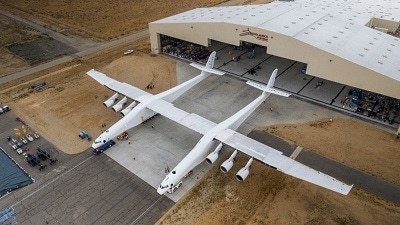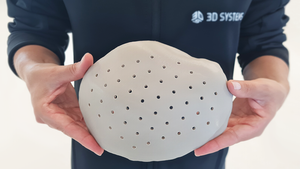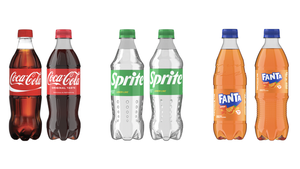Manufacturers of the Stratolaunch air-launch platform used Collier Research’s automated sizing and analysis software to inform laminate design and production, reducing structure weight considerably.
October 5, 2017

When the Stratolaunch aircraft rolled out of the Mojave, California Air and Space Port hangar this spring in preparation for ground testing, it was a clear example of how far the design and manufacturing of composite materials have progressed in recent years. Last month the first phase of engine testing on the aircraft’s six Pratt & Whitney turbofan engines was completed.
|
Stratolaunch aircraft rolling out of the hangar in spring 2017. Image courtesy Stratolaunch Systems Corp. |
|
Early construction phase of one of the two fuselages of the all-composite Stratolaunch aircraft and (inset) a screenshot showing a HyperSizer analysis of the structure. Images courtesy Stratolaunch Systems Corp. |
The world’s largest aircraft by wingspan (wider than a football field is long) is almost entirely fabricated from composite materials, which provide light weight, high stiffness and strength characteristics that are increasingly in demand in aerospace, automotive, sports, medical and industrial fields.
The Stratolaunch aircraft is the brainchild of Stratolaunch System Corporation founder Paul G. Allen. It has two fuselages connected by a giant single wing and is powered by six engines that will enable it to take off from a runway carrying a payload of up to 550,000 lbs. At the cruising altitude of a commercial airliner, the Stratolaunch air-launch platform will release the space launch vehicle payload and return to the airport for reuse. The first launch demonstration is anticipated to take place as early as 2019.
Collier Research’s HyperSizer optimization software was used extensively by manufacturer Scaled Composites to optimize the aircraft’s composite fuselage and wing structure. HyperSizer, the first software package to be commercialized out of NASA, has been employed on a wide variety of aerospace and other industry projects fabricated with composite or metallic materials. The software automatically performs design, stress analysis and sizing optimization, typically reducing the weight of structures by 20-40%.
“To ensure the most efficient use of materials in an all-composite structure of any size requires effective employment of design and manufacturing optimization tools from the very earliest stages,” says Collier Research president Craig Collier.
For the massive Stratolaunch wing, deflection limits were a significant factor to be taken into account. The panels of the duel fuselages were sized for strength, stability and honeycomb sandwich failure modes. By using HyperSizer, the stress team had access to a comprehensive set of automated failure analyses that includes rapid free-body analysis, discrete laminate sizing, ply-based composite failure analysis, honeycomb sandwich analysis methods such as wrinkling, core shear, flatwise tension and intracell dimpling, and scripting API to push in loads from Excel spreadsheets.
Collier is seeing continuing evolution in the integration of the toolsets used for composites design and manufacturing. “HyperSizer software can provide insight into how producible a structure is and whether there might be any manufacturing issues,” says Craig Collier. “It can incorporate laminate fabrication preferences in early-stage design thought; ease-of-manufacturing is becoming a major influence with strength design of laminate structures.”
Collier Research Corporation provides software solutions, methods research, and consulting services for the aerospace, wind energy, automotive, and recreational equipment industries with its broad range of structural capabilities.
About the Author(s)
You May Also Like






